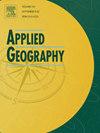Optimal land sharing/sparing pattern to synergize grain yield and ecosystem services of cropland: A case study of Chengdu, China
IF 5.4
2区 地球科学
Q1 GEOGRAPHY
引用次数: 0
Abstract
Sustainable intensification of agricultural landscapes requires innovative approaches to reconcile food production with ecological conservation. While the land sparing and sharing framework has advanced our understanding of biodiversity–yield trade-offs, critical gaps remain in addressing multifunctional ecosystem services and spatial scale effects. This study proposes an integrated “Yield–LSS–ESS” framework incorporating grain yield, land sparing/sharing index (LSS), and four key ecosystem services (carbon sequestration, hydrological regulation, soil regulation, and habitat quality). Applying this framework to Chengdu, China (2000–2020), we conducted multi-scale spatial analyses (1–10 km grids) combined with multi-scenario potential assessments to identify optimal land-use patterns. Results demonstrate that strategic landscape reconfiguration could simultaneously increase grain production by 2.50 % (5.71 million tons) and enhance ecosystem services by 4.46 %. The 9 × 9 km spatial scale emerged as optimal for implementing land–use strategies, achieving robust model fits for “Yield–LSS–ESS” relationships. This study presents a spatially explicit and scalable framework that links landscape configuration with multifunctional ecosystem services, identifies critical spatial scales for agricultural decision-making, and provides empirical evidence to guide context-specific land-use optimization. These insights offer practical guidance for policymakers balancing food security and ecological sustainability amid rapid urbanization and intense land-use pressures.
土地共享/节约优化模式对粮食产量和农田生态系统服务的协同作用——以成都市为例
农业景观的可持续集约化需要创新的方法来协调粮食生产与生态保护。虽然土地节约和共享框架促进了我们对生物多样性产量权衡的理解,但在解决多功能生态系统服务和空间规模效应方面仍存在重大差距。本研究提出了一个整合粮食产量、土地节约/共享指数(LSS)和四种关键生态系统服务(碳固存、水文调节、土壤调节和栖息地质量)的综合“产量- LSS - ess”框架。将该框架应用于中国成都(2000-2020),我们进行了多尺度空间分析(1-10公里网格),并结合多情景潜力评估来确定最优土地利用模式。结果表明,战略性景观重构可使粮食产量增加2.50%(571万吨),生态系统服务功能增加4.46%。9 × 9公里的空间尺度是实施土地利用策略的最佳选择,实现了适合“产量-低成本-低成本”关系的稳健模型。该研究提出了一个空间明确的可扩展框架,将景观配置与多功能生态系统服务联系起来,确定了农业决策的关键空间尺度,并为指导特定环境的土地利用优化提供了经验证据。这些见解为决策者在快速城市化和巨大的土地利用压力下平衡粮食安全和生态可持续性提供了实用指导。
本文章由计算机程序翻译,如有差异,请以英文原文为准。
求助全文
约1分钟内获得全文
求助全文
来源期刊

Applied Geography
GEOGRAPHY-
CiteScore
8.00
自引率
2.00%
发文量
134
期刊介绍:
Applied Geography is a journal devoted to the publication of research which utilizes geographic approaches (human, physical, nature-society and GIScience) to resolve human problems that have a spatial dimension. These problems may be related to the assessment, management and allocation of the world physical and/or human resources. The underlying rationale of the journal is that only through a clear understanding of the relevant societal, physical, and coupled natural-humans systems can we resolve such problems. Papers are invited on any theme involving the application of geographical theory and methodology in the resolution of human problems.
 求助内容:
求助内容: 应助结果提醒方式:
应助结果提醒方式:


